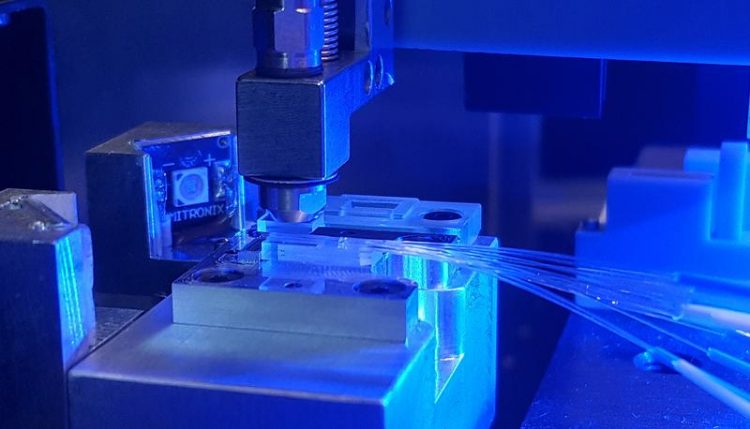Fraunhofer IPT presents platform for automated precision assembly of polarized optical fibers

After the bonding of the individual fibers, a lid component is aligned with high precision and bonded to finalise the assembly. Foto: Fraunhofer IPT
With so-called single-mode fiber arrays, the precise arrangement of the individual fibers is crucial.
Up to 32 light-conducting fibers are mounted in several layers in one connector – today, they are usually still glued manually and individually in the connector, since the correct alignment of each individual fiber determines whether the component can perform the desired data transmission.
The assembly system can now take over this complex and thus costly task:
The system automates all of the essential process steps for manufacturing the connectors – from storage and feeding of the fibers to rotary and translational alignment, gluing and hardening of individual fibers through to final assembly of the entire system into a linear fiber array.
Today, the system can already assemble connectors with up to 16 fiber connections autonomously. Further developments now aim not only to increase the number of fibers processed, but also to improve the handling of the non-rigid fibers and thus further accelerate the entire production process.
Project partners:
– Aixemtec GmbH, Aachen
– Fraunhofer Institute for Production Technology IPT, Aachen
– Phix B.V., Enschede, Netherlands
– University of Twente, Enschede, Netherlands
Maximilian Hoeren M.Sc.
Fraunhofer-Institut für Produktionstechnologie IPT
Steinbachstraße 17
52074 Aachen
www.ipt.fraunhofer.de
maximilian.hoeren@ipt.fraunhofer.de
http://www.ipt.fraunhofer.de/en/Press/Pressreleases/20190627-fraunhofer-ipt-pres…
Media Contact
All latest news from the category: Trade Fair News
Newest articles

Red light therapy for repairing spinal cord injury passes milestone
Patients with spinal cord injury (SCI) could benefit from a future treatment to repair nerve connections using red and near-infrared light. The method, invented by scientists at the University of…

Insect research is revolutionized by technology
New technologies can revolutionise insect research and environmental monitoring. By using DNA, images, sounds and flight patterns analysed by AI, it’s possible to gain new insights into the world of…

X-ray satellite XMM-newton sees ‘space clover’ in a new light
Astronomers have discovered enormous circular radio features of unknown origin around some galaxies. Now, new observations of one dubbed the Cloverleaf suggest it was created by clashing groups of galaxies….





















